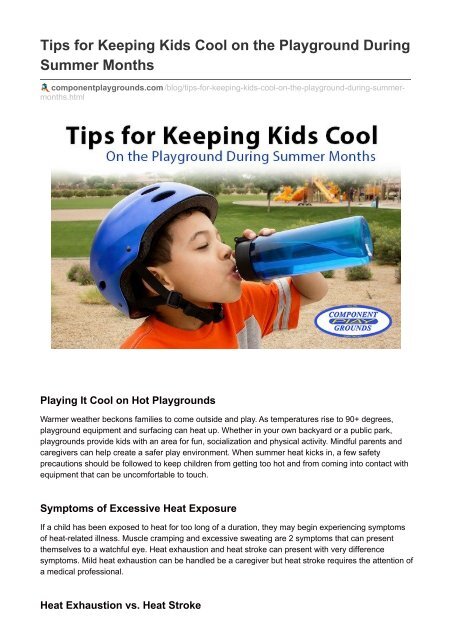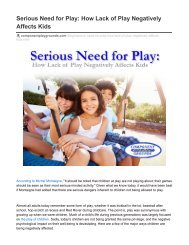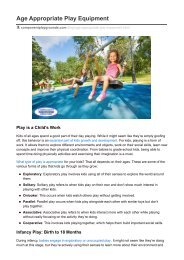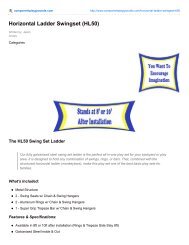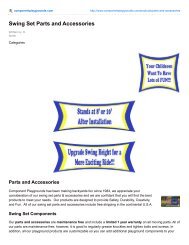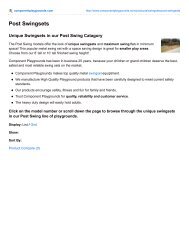Tips for Keeping Kids Cool on the Playground During Summer Months
Playing It Cool on Hot Playgrounds Warmer weather beckons families to come outside and play. As temperatures rise to 90+ degrees, playground equipment and surfacing can heat up. Whether in your own backyard or a public park, playgrounds provide kids with an area for fun, socialization and physical activity. Mindful parents and caregivers can help create a safer play environment. For more, visit us online at: http://www.componentplaygrounds.com/
Playing It Cool on Hot Playgrounds
Warmer weather beckons families to come outside and play. As temperatures rise to 90+ degrees, playground equipment and surfacing can heat up. Whether in your own backyard or a public park, playgrounds provide kids with an area for fun, socialization and physical activity. Mindful parents and caregivers can help create a safer play environment. For more, visit us online at: http://www.componentplaygrounds.com/
You also want an ePaper? Increase the reach of your titles
YUMPU automatically turns print PDFs into web optimized ePapers that Google loves.
<str<strong>on</strong>g>Tips</str<strong>on</strong>g> <str<strong>on</strong>g>for</str<strong>on</strong>g> <str<strong>on</strong>g>Keeping</str<strong>on</strong>g> <str<strong>on</strong>g>Kids</str<strong>on</strong>g> <str<strong>on</strong>g>Cool</str<strong>on</strong>g> <strong>on</strong> <strong>the</strong> <strong>Playground</strong> <strong>During</strong><br />
<strong>Summer</strong> M<strong>on</strong>ths<br />
comp<strong>on</strong>entplaygrounds.com /blog/tips-<str<strong>on</strong>g>for</str<strong>on</strong>g>-keeping-kids-cool-<strong>on</strong>-<strong>the</strong>-playground-during-summerm<strong>on</strong>ths.html<br />
Playing It <str<strong>on</strong>g>Cool</str<strong>on</strong>g> <strong>on</strong> Hot <strong>Playground</strong>s<br />
Warmer wea<strong>the</strong>r beck<strong>on</strong>s families to come outside and play. As temperatures rise to 90+ degrees,<br />
playground equipment and surfacing can heat up. Whe<strong>the</strong>r in your own backyard or a public park,<br />
playgrounds provide kids with an area <str<strong>on</strong>g>for</str<strong>on</strong>g> fun, socializati<strong>on</strong> and physical activity. Mindful parents and<br />
caregivers can help create a safer play envir<strong>on</strong>ment. When summer heat kicks in, a few safety<br />
precauti<strong>on</strong>s should be followed to keep children from getting too hot and from coming into c<strong>on</strong>tact with<br />
equipment that can be uncom<str<strong>on</strong>g>for</str<strong>on</strong>g>table to touch.<br />
Symptoms of Excessive Heat Exposure<br />
If a child has been exposed to heat <str<strong>on</strong>g>for</str<strong>on</strong>g> too l<strong>on</strong>g of a durati<strong>on</strong>, <strong>the</strong>y may begin experiencing symptoms<br />
of heat-related illness. Muscle cramping and excessive sweating are 2 symptoms that can present<br />
<strong>the</strong>mselves to a watchful eye. Heat exhausti<strong>on</strong> and heat stroke can present with very difference<br />
symptoms. Mild heat exhausti<strong>on</strong> can be handled be a caregiver but heat stroke requires <strong>the</strong> attenti<strong>on</strong> of<br />
a medical professi<strong>on</strong>al.<br />
Heat Exhausti<strong>on</strong> vs. Heat Stroke
Heat exhausti<strong>on</strong> can range from milder <str<strong>on</strong>g>for</str<strong>on</strong>g>ms to more severe. A school nurse can appropriately treat<br />
mild <str<strong>on</strong>g>for</str<strong>on</strong>g>ms of heat exhausti<strong>on</strong>.<br />
According to <strong>the</strong> Centers <str<strong>on</strong>g>for</str<strong>on</strong>g> Disease C<strong>on</strong>trol and Preventi<strong>on</strong>, symptoms of heat exhausti<strong>on</strong> include:<br />
Heavy sweating<br />
Weakness<br />
Cold, pale, and clammy skin<br />
Fast, weak pulse<br />
Nausea or vomiting<br />
Fainting<br />
Remove <strong>the</strong> child to a cooler area, apply cold cloths to exposed areas and have <strong>the</strong>m sip water. If a<br />
child has vomited and it c<strong>on</strong>tinues, caregivers should seek <strong>the</strong> attenti<strong>on</strong> of a medical professi<strong>on</strong>al.<br />
Heat stroke presents symptoms that are markedly different from heat exhausti<strong>on</strong>. Heat stroke is a<br />
medical emergency and so caregivers need to call 911 immediately. In this case, do not give fluids to<br />
<strong>the</strong> affected individual.<br />
Symptoms of heat stroke include:<br />
High body temperature (above 103 degrees F)<br />
Hot, red, dry or moist skin<br />
Rapid and str<strong>on</strong>g pulse<br />
Possible unc<strong>on</strong>sciousness<br />
Caregivers can move <strong>the</strong> child to a cooler envir<strong>on</strong>ment and reduce <strong>the</strong> child’s body temperature with<br />
cooling cloths or even a cool bath. This is occurring while waiting <str<strong>on</strong>g>for</str<strong>on</strong>g> medical pers<strong>on</strong>nel to arrive.<br />
<strong>Playground</strong> Hot Spots<br />
The CPSC advises parents and school pers<strong>on</strong>nel to regularly check playground equipment during peak<br />
daylight hours.<br />
Some factors to take into c<strong>on</strong>siderati<strong>on</strong> are:<br />
Black surfaces get hotter than those painted white, blue or red.<br />
Humidity affects <strong>the</strong> temperature of playground equipment.<br />
Some materials of <strong>the</strong> playground surfacing, such as solid steel decks, slides and steps, can get<br />
hotter than o<strong>the</strong>r alternatives.<br />
<strong>Playground</strong>s that are shaded have generally cooler surfaces.<br />
The length of playtime and <strong>the</strong> amount of sun exposure will affect surfaces and children.<br />
All of <strong>the</strong>se variants can affect <strong>the</strong> surface temperatures of playground equipment and should be<br />
regularly m<strong>on</strong>itored during <strong>the</strong> summer m<strong>on</strong>ths.<br />
How to Keep Children <str<strong>on</strong>g>Cool</str<strong>on</strong>g> in Hot parks and <strong>Playground</strong>s<br />
Let cooler heads prevail and have adults work to create safer play envir<strong>on</strong>ments by adjusting elements<br />
and time of play.<br />
Some methods to create “cool” play are to:<br />
Incorporate shade elements into new playground designs and adding <strong>the</strong>m to existing<br />
playgrounds. Shade elements will help protect surfaces and children from direct sunlight
during <strong>the</strong> peak hours of <strong>the</strong> day and offer a respite from <strong>the</strong> heat <str<strong>on</strong>g>for</str<strong>on</strong>g> children to move and rest<br />
between activities.<br />
Avoid play between <strong>the</strong> hours of No<strong>on</strong> - 3:00 PM. The sun is directly overhead and <strong>the</strong><br />
effects are most significant during those hours. Schools can have children play indoors <strong>on</strong><br />
particularly hot days or have <strong>the</strong>m play earlier or later in <strong>the</strong> day.<br />
Wear clothing that is light, breathable and covers bare skin. If kids are sent out to play<br />
during peak hours, such as at <strong>the</strong> end or beginning of <strong>the</strong> school year, make sure that <strong>the</strong>y are<br />
wearing cott<strong>on</strong> clothing and pants <strong>on</strong> <strong>the</strong> slide. When taking children out to play, seek out<br />
playgrounds with shady coverings or water play-sets.<br />
Assess <strong>the</strong> wea<strong>the</strong>r - Keep an eye out <strong>on</strong> <strong>the</strong> humidity and UV levels. Humidity can increase<br />
<strong>the</strong> percepti<strong>on</strong> of heat and reduce <strong>the</strong> ability <str<strong>on</strong>g>for</str<strong>on</strong>g> <strong>the</strong> body to experience <strong>the</strong>rmal com<str<strong>on</strong>g>for</str<strong>on</strong>g>t. This is<br />
<strong>the</strong> degree of com<str<strong>on</strong>g>for</str<strong>on</strong>g>t that bodies feel in <strong>the</strong>ir surrounding envir<strong>on</strong>ment. It is achieved when <strong>the</strong><br />
heat generated by a body is able to dissipate into <strong>the</strong> envir<strong>on</strong>ment. High humidity can interfere<br />
with this process. UV levels of 1 to 5 are generally safe <str<strong>on</strong>g>for</str<strong>on</strong>g> some protected exposure. According<br />
to <strong>the</strong> EPA, UV radiati<strong>on</strong> can be damaging to <strong>the</strong> skin, suppress <strong>the</strong> immune system and lead to<br />
premature aging.<br />
Recognize symptoms of overheating. Watch <str<strong>on</strong>g>for</str<strong>on</strong>g> signs of discom<str<strong>on</strong>g>for</str<strong>on</strong>g>t with children at play.<br />
Symptoms include muscle cramping, nausea, dizziness, disorientati<strong>on</strong>, turning pale or<br />
excessive sweating. Avoid heat exhausti<strong>on</strong> and heat stroke by making sure your children drink<br />
enough water and rest every 20 minutes or so between activities.<br />
Hydrate kids- Send child to school or to caregivers with a water bottle. Instruct <strong>the</strong>m to refill as<br />
necessary especially prior to going outside. Schools can permit children to drink from <strong>the</strong> water<br />
fountain <strong>on</strong> <strong>the</strong>ir return to <strong>the</strong> classroom.<br />
Educate children about <strong>the</strong> dangers of overheating and how to recognize symptoms in a<br />
friend. Both parents and schools and help instruct children <strong>on</strong> safe play when temperatures<br />
heat up. Parents and caregivers can bring spray bottles to spray down <strong>the</strong> slides or kids.<br />
Parents and school aides can give kids popsicles to cool down – otter pops are a great,<br />
inexpensive treat or you can freeze juice boxes <str<strong>on</strong>g>for</str<strong>on</strong>g> a mini-slushy.<br />
C<strong>on</strong>tact a <strong>Playground</strong> Planning Professi<strong>on</strong>al<br />
Whatever you do, d<strong>on</strong>’t let <strong>the</strong> heat keep you indoors. Enjoy <strong>the</strong> sunshine and play safely with<br />
preparati<strong>on</strong> and better equipment. For over 30 years, Comp<strong>on</strong>ent <strong>Playground</strong>s has adapted existing<br />
playgrounds by creating cooler safe play c<strong>on</strong>diti<strong>on</strong>s and has designed durable kid-tested playgrounds<br />
that can withstand generati<strong>on</strong>s of use. C<strong>on</strong>tact Comp<strong>on</strong>ent <strong>Playground</strong>s at 877-530-0222 <str<strong>on</strong>g>for</str<strong>on</strong>g> help<br />
planning your next playground.


